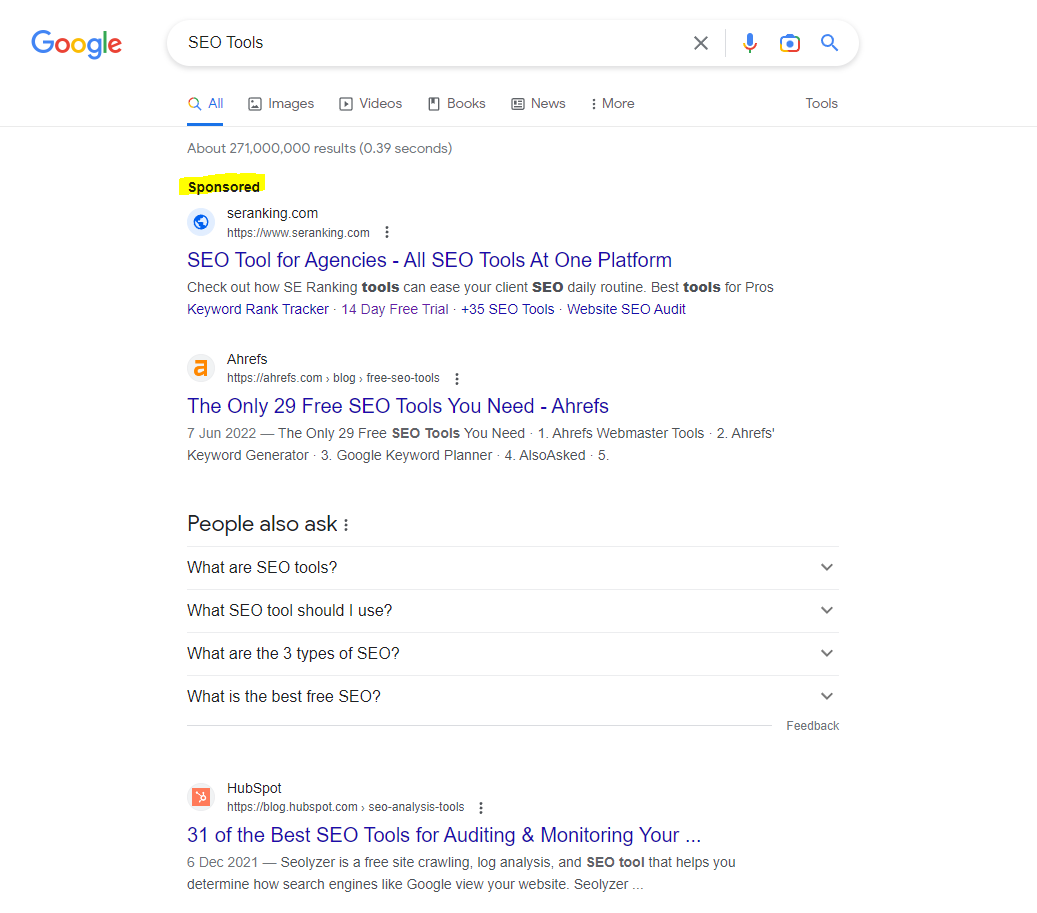In this article, we’ll be looking at the reasons why the click-through rate for a page or query is dropping in Google Search Console, even though the ranking position has not changed (or maybe even improved!).
Most of the reasons listed here ultimately require you to do some manual investigation of the SERPs for the affected queries or pages.
SERP stands for Search Engine Results Page – effectively the search results from Google that the user sees. The term is used throughout this article.
Let’s dive in!
SERP Layout Changes
Google will often change the layout of the SERPs and introduce more search features to move the organic search listings further down the page.
Common search features that move organic listings further down the page include:
- Video carousel
- Image pack
- Featured snippet
- Calculators/Translators
- Maps
Various SERP features can appear in the middle of the SERP results as well
- People Also Ask panel
- Related searches
Anything that pushes the organic listing more pixels down the page will decrease the likelihood of a user scrolling down and clicking on them. Ultimately this negatively affects the click-through rate.
Featured Snippet
We have already mentioned featured snippets in the SERP layout changes, but they are such an important SERP feature they deserve their own section.
A featured snippet can decimate the click-through rates of the results on the first page of Google, especially if it answers the searcher’s query in full. This is what is known as a zero-click search query/result.
If it’s a zero-click featured snippet – it’s still better for you to be there than one of your competitors. In fact, a Search Engine Land study completed back in 2017 showed that when a featured snippet is present, the CTR for the first organic result falls below 20%! It also concluded that the URL appearing within the featured snippet takes 8% of all clicks.
Google Ads
Google may have increased the number of paid ads it displays above the organic search listings.
This will push your entry in the SERPs more pixels down. While it will be getting the same number of impressions, it will be less likely that a user will scroll down to click it, so the click-through rate will drop.
It’s also worth noting that Google makes it incredibly difficult to tell the difference between a paid advertisement and an organic listing within their search results. As a result of this, more users could be inadvertently clicking on ads rather than organic results anyway.

Page Title and Meta Description changes
If you have made changes to your page title (make sure to run it through our meta title checker) or meta description, these changes could be negatively affecting your click-through rate. If your title or meta description is less attractive to users, in terms of “will that page answer my query”, fewer people will click on it.
Also, Google may have decided to re-write your page title or meta description. Check the SERPs to see what page title and meta description Google is displaying for your page. As of September 2020, Google was rewriting meta descriptions over 70% of the time.
Structured Data Changes
If you are using structured data on your page, you may be getting some rich results applied to your listing in the SERPs.

Rich results add extra information to your listing, and take up more pixel space in the SERPs.
Anything that gives you more space in the SERPs can usually improve your click-through rate for the position you are in.
But has there been an issue with the structured data that has meant the rich results have been removed without you realising? A drop in click-through rate could be an indication that this has happened.
Increase in Impressions
Your page or query may have improved the position it ranks, but unfortunately, impressions and clicks do not track linearly. This means clicks do not increase at the same rate as impressions.
You may have moved from position 12 in the SERPs (on page 2) into position 8. While this will lead to a large increase in impressions, the clicks may not jump as much. This would lead to a drop in click-through rate.
Increase in the number of queries a page ranks for
If your page starts to rank for a larger set of queries due to a content update being performed, these queries may have a lower click-through rate than the pre-update queries.
This will mean the average click-through rate of the page will drop post-update.
To check if this is the case, you’ll need to check the total number of queries pre and post-update.
Frequently Asked Questions
Why is my CTR dropping in Google Search Console?
Your CTR may drop if Google changes the SERP layout. New features like video carousels or featured snippets can push your link lower down the page.
How do featured snippets affect CTR?
Featured snippets often answer the query in full. This leads to fewer clicks. Being featured is still better than letting a competitor take the spot.
Can Google Ads lower my organic click-through rate?
Yes. More ads above the fold push organic listings down. This makes them less visible and can reduce CTR.
Why would changing a page title or meta description lower CTR?
If your new title or meta is less compelling users may skip your link. Google might also rewrite your meta description which can impact clicks.
What happens if rich results disappear from my listing?
You may lose clicks if structured data errors cause rich results to vanish. Check if rich elements like star ratings are still visible.
Can more impressions lower CTR?
Yes. If impressions grow faster than clicks your CTR drops. This can happen when ranking moves from page 2 to the bottom of page 1.
Why would a content update lower CTR?
Your page may rank for new queries with lower CTR. This affects the average CTR even if rankings improve.


